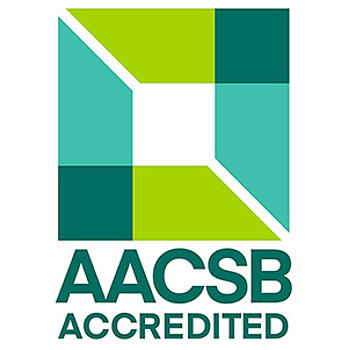This Website uses cookies to improve your visit on our website. More Info
Munich Business School
- MBS QUICK FACTS:
- State-recognized since 1999
- February & September
- German/English

AACSB stands for the Association to Advance Collegiate Schools of Business. It is a nonprofit accreditation body that evaluates and endorses the quality of business and accounting programs at universities and colleges around the world. Founded in 1916 in the United States, AACSB is one of the oldest and most prestigious accrediting agencies in business education. As of now, only around 1,000 schools in the world are AACSB-accredited — out of more than 16,000 business schools globally. This makes AACSB a mark of elite status in business education.
The AACSB’s mission is to foster engagement, accelerate innovation, and amplify impact in business education. In simpler terms, it helps ensure that business schools are:
AACSB provides two types of accreditation:
An AACSB-accredited business school gives you credibility, quality, and connections—which all translate to better jobs, higher pay, and long-term career flexibility. Here’s why it matters for you as a student in detail:
AACSB schools often attract driven students and maintain solid industry ties, which means:
These relationships can help with internships, job placements, and career advice.
If you’re thinking about an MBA or even a PhD later, many top programs prefer or require undergrad degrees from AACSB schools. It keeps doors open for:
AACSB schools often work with real businesses on:
So you’re learning practical knowledge that actually applies in the real world.
AACSB accreditation is a gold standard for business schools. Only about 6% of business schools worldwide earn it. It means the school:
So you're getting a program that’s legit and up-to-date.
Employers know AACSB. Many global companies prefer or even require it when hiring for business roles, especially for:
It can give your résumé more weight.
If you’re aiming for a serious career in business, especially in finance, consulting, entrepreneurship, or international roles, an AACSB-accredited school is usually the better investment. It signals quality and commitment — to employers and grad schools alike.
Here's a side-by-side comparison table that shows how AACSB-accredited business schools typically stack up against non-AACSB schools in key areas:
| Category | AACSB-Accredited Schools | Non-AACSB Schools |
|---|---|---|
| Reputation | High global recognition and prestige. | Varies widely; may not be recognized internationally. |
| Curriculum Quality | Regularly reviewed, research-based, aligned with industry standards. | May not be as rigorously reviewed or updated. |
| Faculty | Professors are often research-active and industry-experienced. | May rely more on adjuncts or less research-oriented faculty. |
| Career Prospects | Preferred by many top employers and multinational companies. | May be fine for local or regional jobs, but not as competitive globally. |
| Internships & Networking | Strong business connections, career fairs, and alumni networks. | Varies; might not have as many industry partnerships or active alumni. |
| Graduate School Access | More likely to meet admission requirements for top MBA or graduate programs. | Some programs may not be accepted by elite graduate schools. |
| Global Opportunities | Easier to join exchange programs or study abroad with partner institutions. | Limited international partnerships. |
| Cost | Can be more expensive (especially private schools), but often higher Return on Investment in long run. | Often more affordable short-term, but lower starting salaries or placement rates. |
| Accreditation Status | Evaluated regularly for high standards in teaching, research, and student support. | May not undergo the same level of rigorous external review. |
| Innovation & Tech Use | More likely to adopt the latest business tech, analytics, and teaching tools. | May lag in adopting modern business practices and tools. |

"We are proud to have received AACSB accreditation. For us, it is proof of the outstanding quality of teaching and research at Munich Business School and an important milestone for our university. However, the accreditation is not only a confirmation of the hard work and dedication of our faculty, staff and students, but also serves as an incentive to continue to pursue innovative paths in business education."
Prof. Dr. Stefan Baldi
Dean of the Munich Business School
Munich Business School (MBS) achieved a significant milestone in 2025 by earning accreditation from the Association to Advance Collegiate Schools of Business (AACSB). This accomplishment places MBS among an elite group of institutions, as fewer than 6% of business schools worldwide meet AACSB's rigorous standards.
In Germany, MBS joins a select group of fewer than 20 universities that have achieved AACSB accreditation, highlighting its dedication to providing top-tier business education. Earning AACSB accreditation is a testament to MBS's unwavering commitment to academic excellence and its mission to prepare students for successful careers in the global business environment.
Germany’s employers have held Munich Business School graduates in particularly high regard for years already, as shown by their top positions in the annual WirtschaftsWoche ranking. The AACSB accreditation also confirms the high academic quality internationally.
The process involves several steps and takes many years. On average, it takes about 4–7 years to achieve accreditation after being accepted into the process. Some schools may take longer, depending on how much they need to improve. Here is an overview of this long process:
| 1. Eligibility Application | The school first submits an Eligibility Application to AACSB, which outlines: Its mission, vision, and values, Programs offered (like BBA, MBA, etc.), Faculty qualifications, Resources and facilities and Commitment to continuous improvement. If AACSB approves, the school becomes a “Member” and enters the accreditation process. |
|---|---|
| 2. Developing an Initial Self-Evaluation Report (iSER) | The school prepares an Initial Self-Evaluation Report, which explains: How the school currently meets (or plans to meet) AACSB’s standards and its strategies for closing any gaps. This is basically a roadmap to full accreditation. It’s reviewed by a mentor (appointed by AACSB) who helps guide the school. |
| 3. Implementation Phase | Now the real work begins. This phase can take 2–7 years depending on the school’s readiness. During this time, the school: Improves or updates its curriculum, Hires more qualified faculty, Builds or refines its assessment processes, Collects data on student learning outcomes and Strengthens ties with business communities. All of this is aimed at aligning the school with AACSB’s 15 accreditation standards. |
| 4. Final Self-Evaluation Report | Once the school believes it meets all AACSB standards, it submits a Final Self-Evaluation Report. This is a formal declaration that says: “We’re ready. Here’s how we meet each accreditation standard.” |
| 5. Peer Review Visit | A team of three peer reviewers (experienced deans/faculty from other AACSB schools) visits the campus for a few days. They: Interview faculty, students, staff, and leadership, Review documents and data and Observe classes, facilities, and culture. They assess whether the school meets AACSB’s expectations in practice, not just on paper. |
| 6. Accreditation Decision | After the visit, the peer review team submits a report and makes a recommendation to the AACSB Initial Accreditation Committee (IAC). If approved, the school is granted AACSB Accreditation for 5 years, after which it must go through a Continuous Improvement Review to keep its status. |
The most prestigious business school accreditation is AACSB (Association to Advance Collegiate Schools of Business), recognized globally for its rigorous standards and elite status.
AACSB focuses on the overall quality and continuous improvement of a business school, while AMBA specifically accredits individual MBA, DBA, and master's programs with a focus on program impact and student experience.
AACSB emphasizes research, academic rigor, and continuous improvement, while ACBSP focuses more on teaching excellence and student outcomes, making it more accessible for teaching-oriented institutions.
A business school ideally needs AACSB, AMBA, or EQUIS accreditation to ensure international recognition, quality assurance, and credibility.
AACSB accreditation is considered the highest standard in business education, recognized globally for its rigor, prestige, and assurance of academic excellence.